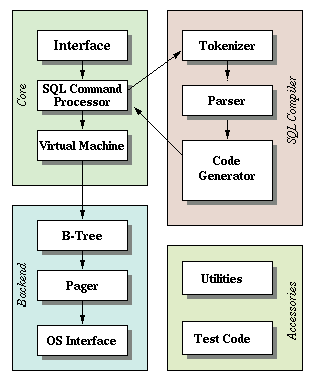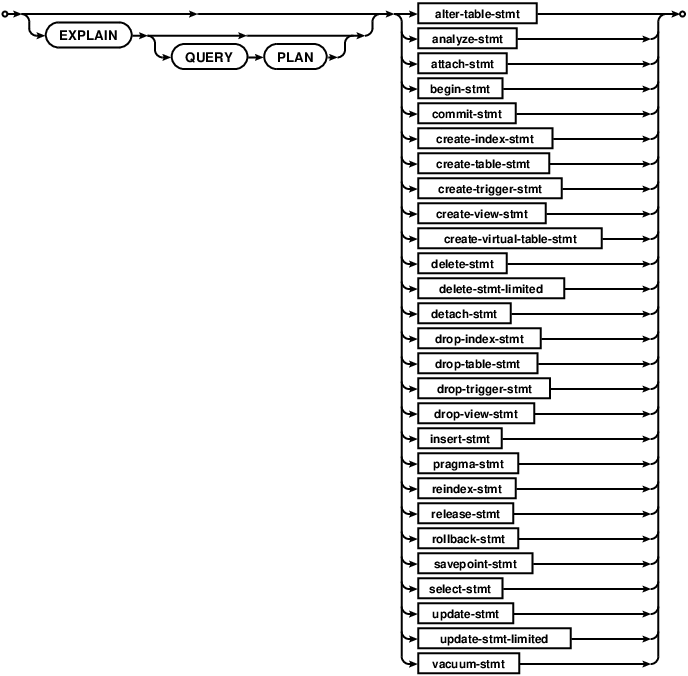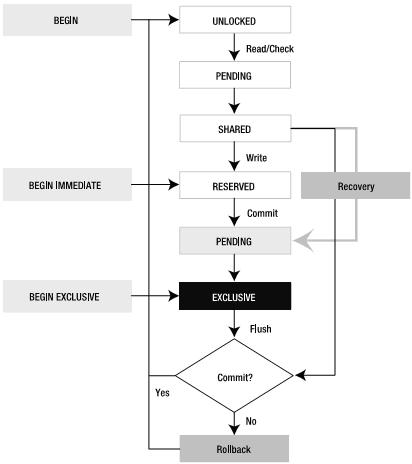* 배운 내용 복습 차원으로 여기저기 찾아보며 정리 중
SQLite and Android
 | |
| Developer(s) | D. Richard Hipp |
|---|---|
| Initial release | August 2000 |
| Stable release | 3.7.17 / May 20, 2013 |
| Written in | C |
| Operating system | Cross-platform |
| Size | ~350 KiB |
| Type | RDBMS (embedded) |
| License | Public domain[1] |
| Website | sqlite.org |
SQLite - Wikipedia
[SQLite] SQLite 소개 및 특징
[장점]
- 뛰어난 이식성 : 동적 데이터 타입 지원
- 작은 크기
- public domain license : http://www.sqlite.org/copyright.html
- 신뢰성, 편의성
[단점]
- 동시성 : read시 block 가능, 동시 writting 불가
- left outerjoing만 지원
[Architecture]
| Block Diagram Of SQLite |
|---|
 |
* GIF라 안드로이드에서는 보이지 않으니 위 링크를 참고하세요~
- Backend 중 일부
. B-Tree : DB의 table과 index를 관리하기 위해 B-Tree 구조를 사용하며 DB 파일에서 페이지들을 유지 관리(정렬, 연결)
. Pager(Page Cache) : B-Tree 구조를 사용하여 저장된 DB를 구성하는 정보(chunk 단위)를 디스크로 부터 read/write
: database locking, transaction manage 제어 포함
[Data type]
Integer, Real(부동소수점), Text, BLOB, NULL
=> data type을 정하지 않아도 상관없고 다른 type을 집어 넣더라도 SQLite는 들어간다. 헐.
1.0 Storage Classes and Datatypes
Each value stored in an SQLite database (or manipulated by the database engine) has one of the following storage classes:
|
[SQL Syntax]
* Android에서 주로 사용되는 것들 위주로 기준으로 정리

* GIF라 안드로이드에서는 보이지 않으니 위 링크를 참고하세요~
- Transaction Control Language (TCL)
: Transaction
* 기본으로 auto_commit을 지원하여 다량의 데이터 입력 시 transaction을 사용하는것 추천
. begin : SQLiteDatabase.beginTransaction()
=> Listener 여부, Transaction 시 EXCLUSIVE / IMMEDIATE mode 사용 여부에 따른 기타 API 존재
| ||||||||||||||||||||
. commit : SQLiteDatabase.endTransaction()
. transaction 성공 시 : SQLiteDatabase.setTransactionSuccessful()
. rollback : 명시적인 API는 없고 setTransactionSuccessful()를 호출하지 않는 경우.
Here is the standard idiom for transactions:
db.beginTransaction(); try { ... db.setTransactionSuccessful(); } finally { db.endTransaction(); } |
- Data Definition Language (DDL)
: 데이터의 구조(Table) 생성, 변경, 제거
|
Execute a single SQL statement that is NOT a SELECT or any other SQL statement that returns data.
It has no means to return any data (such as the number of affected rows). Instead, you're encouraged to use
insert(String, String, ContentValues), update(String, ContentValues, String, String[]), et al, when possible.
When using
enableWriteAheadLogging(), journal_mode is automatically managed by this class. So, do not set journal_mode using "PRAGMA journal_mode'<value>" statement if your app is using enableWriteAheadLogging()</value>
|
sql
|
the SQL statement to be executed. Multiple statements separated by semicolons are not supported.
|
|---|
Throws
if the SQL string is invalid
|
* SQLite는 부가적으로 IF NOT EXIST 같은 구문을 지원한다.
. 예를 들어 CREATE TABLE student (); 같은 구문을 실행할 때 만약 student table이 있다면 에러가 발생되지만
CREATE TABLE IF NOT EXIST student (); 를 실행할 경우 만약 존재한다면 만들지 않음
DROP TABLE IF EXIST student; 도 같은 맥락
- SQLiteOpenHelper 구현 참고
: SQLite DB 생성 및 업그레이드 를 위한 일반적인 구현 예제
. SQLite DB schema 변경으로 DB 재생성을 위해서는 직접 Delete & Create 코드를 실행하는 것도 방법이지만
. DB version을 올린 상태로 app을 배포하면 자동으로 DB 재생성/업데이트 함.
. WAL mode setting 가능(public void setWriteAheadLoggingEnabled (boolean enabled), 단 단말과 버전에 따라 미구현일수도 )
|
- Data Manipulation Language (DML)
: 데이터의 삽입, 수정, 삭제
. INSERT, UPDATE, DELTE 등
. Android SQLiteDatabase에서 지원하는 API는 다양하다..
=> execSQL, insert, update, delete...
- Android SQLiteDataBase API들을 사용한 SQLite 처리 예제
: 기본적으로 참고할 만한 소스, 좀 이상한 부분도 있으니 댓글을 보고 해당 사항 검토 필요,
⇒All CRUD Operations (Create, Read, Update and Delete)
Now we need to write methods for handling all database read and write operations. Here we are implementing following methods for our contacts table.
⇒Inserting new Record
The addContact() method accepts Contact object as parameter. We need to build ContentValues parameters using Contact object. Once we inserted data in database we need to close the database connection.
⇒Reading Row(s)
The following method getContact() will read single contact row. It accepts id as parameter and will return the matched row from the database.
getAllContacts() will return all contacts from database in array list format of Contact class type. You need to write a for loop to go through each contact.
getContactsCount() will return total number of contacts in SQLite database.
⇒Updating Record
updateContact() will update single contact in database. This method accepts Contact class object as parameter.
⇒Deleting Record
deleteContact() will delete single contact from database.
|
* Conflict Resolution Algorithms
: 데이터 입력,수정 시 Table의 제약조건(primary key, unique 속성 등)과 충돌 시 처리하도록 설정할 수 있음.
. Abort : 제약 조건의 위반 시 Transaction내 DML 구문 전체를 취소하고 Transaction은 유지 함.
. Rollback : 모든 Transaction 취소
. Fail : Transaction내에서 위반하기 전까지 결과는 유지되고 Transaction 유지
. Ignore : 위반한 구문만 무시하고 모두 진행하고 트랜잭션 유지
. Replace : 위반 시 기존 레코드에 덮어 씀.
long insertWithOnConflict(String table, String nullColumnHack, ContentValues initialValues,int conflictAlgorithm)
General method for inserting a row into the database.
int updateWithOnConflict(String table, ContentValues values, String whereClause, String[] whereArgs, int conflictAlgorithm)
Convenience method for updating rows in the database.
| ||||||||||||||||||||||||||||||
- Query
: 데이터의 검색 시 사용, SELECT
|
[SQLite 내장함수]
- Core Functions
- Date and Time Functions
- Aggregate Functions
: Performance로 인해 DISTINCT를 명시한 field에 대해서만 사용 필요,
non-null values를 대상으로 수행.
[Trigger]
나중에..
[SQLite를 사용한 트리거 (Trigger) 의 이해 그리고 사용 방법]
[Index]
나중에..
[Transaction]
Atomic Commit In SQLite
: 이거 다 읽어보면 될것 같지만.. 귀찮음. 배운 내용+ 다른 블로그 보며 정리함..
- Lock States
http://blog.csdn.net/cctt_1/article/details/5505831

* GIF라 안드로이드에서는 보이지 않으니 위 링크를 참고하세요~
: UNLOCKED
. 트랜잭션을 시작한 상태, 다른 프로세스 r,w 가능
: SHARED
.트랜잭션을 시작 후 r을 실행한 Lock 상태
. 다른 프로세스가 Pending Lock > Exclusive Lock 할 경우 Shared Lock의 트랜잭션이 끝나길 기다림
: RESERVED
. w하려는 상태의 Lock 상태
. 하나의 프로세스가 Reserved Lock을 획득 가능하고 다른 트랜잭션는 r만 가능
. DB의 변경이 아닌 Page cache에 변경된 내용 저장
: PENDING(Reserved Lock 후)
. Commit, Rollback시 Exclusive Lock을 진입하기 위한 전단계, Shared Lock 트랜잭션이 종료되길 기다림
. 하나의 프로세스가 Pending Lock 상태가 되면 다른 트랜젹선들은 Unlocked > Shared Lock으로 변경 불가 (다른 트랜잭션들 r 불가)
=> 이런 골때린 현상을 피하고자 WAL 모두 사용을 추천
: EXCLUSIVE
. Pager가 가지고 있는 변경된 page를 쓰는 Lock 상태
. SQLiteDatabase.beginTrasanction()은 기본적으로 EXCLUSIVE lock을 걸고 시작
* Android SQLiteDatabase에서 제공하는 transaction API들이고 EXCLUSIVE/IMMEDIATE mode로 시작함.
- void beginTransaction() : Begins a transaction in EXCLUSIVE mode.
- void beginTransactionNonExclusive() : Begins a transaction in IMMEDIATE mode.
* 두건의 Transaction이 시작되어 Unlock상태에서 둘다 read를 하여 Shared Lock을 획득한 뒤
한건이 write를 하고자 하여 Reserved Lock을 획득하고 commit하여 Exclusive Lock을 획득하고 하면
다른 Shared Lock 상태의 Transaction을 기다리기 위해 Pending Lock 상태에 머무르게 된다.
=> 이때는 DB를 read 조차 할 수 없는 상태임..
[Journal mode & WAL mode]
Transaction시 Atomic commit과 Rollback 기능을 지원하기 위해 DB이름-journal 이란 파일을 생성하여 사용한다.
- Journal mode
. DELETE : 기본 모드이며 transaction 종료 시 파일이 삭제된다.
. TRUNCATE : transaction 종료 시 파일을 두고 size를 0으로 만든다. 지우는 것 보다는 빠를 듯
. PERSIST : 파일을 지우지 않고 transaction마다 overwrite하여 사용. 별도 file operation이 없음
. MEMORY : 파일을 생성하지 않고 메모리에 기록. 단 process가 죽어 버리면 DB corrupt 가능
. WAL : Rollback Journal 대신 write-ahead log 방법 사용. 3.7.0 이후 부터 지원
. OFF : Rollback journal을 사용하지 않으므로 Rollback이 동작하지 않을 것이고 transaction시 crash나면 DB corrupt 가능
PRAGMA journal_mode = DELETE | TRUNCATE | PERSIST | MEMORY | WAL | OFF
|
- Write-Ahead Logging
. 장단점
: 주요 장점으로는 상대적으로 적은 file operation으로 인해 일반적으로 기존 rollback journal 보다 빠르고 r/w가 동시에 가능함.
: 주요 단점으로는 NFS 같은 것 지원 못하고 r를 주로 사용하는 시나리오에서 느리며 heavy한 transaction(100M이상)의 시나리오에서는 상대적으로 느리고 disk 남은 용량에 영향을 받음.
There are advantages and disadvantages to using WAL instead of a rollback journal.
Advantages include:
But there are also disadvantages:
|
. 동작
: 별도의 WAL 파일을 두어 commit시 수정사항을 WAL에 저장하고 WAL 파일의 "end mark"를 최신 commit 정보로 업데이트
하나의 WAL 파일에는 여러 commit내역이 저장됨.
checkpoint 시점(WAL 파일이 기본 1000 page에 도달될때)에 WAL 파일에 기록된 commit 내역들을 DB에 저장 함.
동시성 고려 및 read performance를 위해 "wal-index"를 shared memory 상에 두어 사용함.
- SQLite's Use Of Temporary Disk Files
: rollback journal file은 DB이름-journal, WAL file은 DB이름-wal & DB이름-shm (shared-memory files)
* 근데 정작 WAL 모드 사용하려니 갤럭시 시리즈에서는 왜 안되는거지?
[관련 링크]
안드로이드(android) 데이타베이스(DB) sqlite3 다루기
Android SQLite 개념 및 예제
[최적화 관련]
- 모바일 디바이스 환경을 위한 SQLite 성능향상 테크닉
- SQLite 최적화 FAQ
[Content Provider 관련]
댓글 없음:
댓글 쓰기